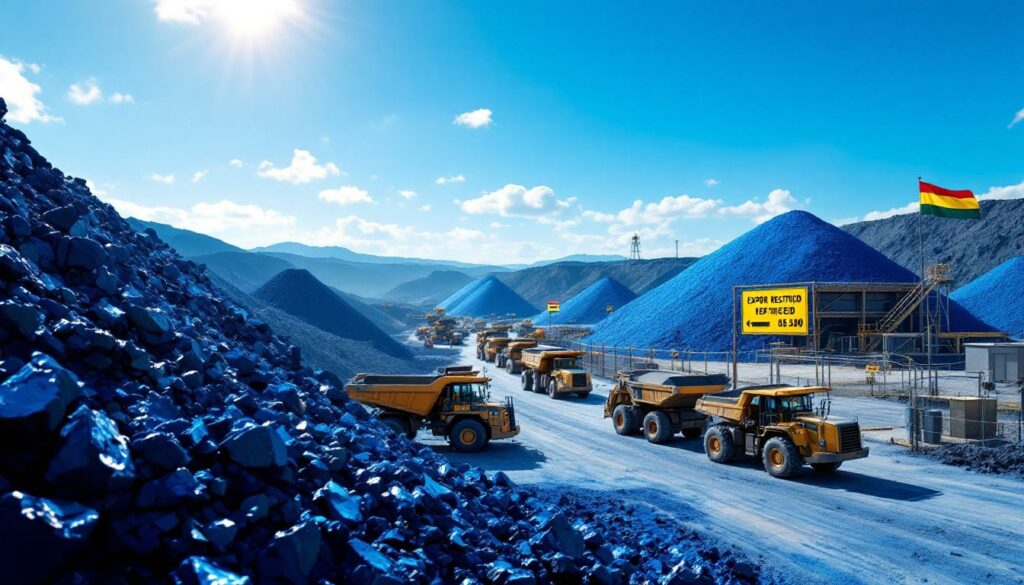How Is CMOC Increasing Cobalt Production During Congo's Export Ban?
In a striking display of operational resilience, CMOC has managed to significantly boost its cobalt production despite facing strict export restrictions from the Democratic Republic of Congo. According to data released by the mining giant, cobalt production reached 61,073 tons in the first half of 2025, marking a robust 13% year-on-year increase despite challenging market conditions.
Second quarter production figures show continued momentum, with output reaching 30,659 tons – slightly outpacing the first quarter's 30,414 tons. This steady quarter-over-quarter growth demonstrates the company's ability to maintain operational excellence even as regulatory hurdles mounted.
Beyond cobalt, CMOC reported equally impressive copper production numbers, with a 13% increase to 353,570 tons during the same January-June 2025 period. This diversified mineral output has contributed to exceptional financial performance, with projected net income between 8.2-9.1 billion yuan ($1.1 billion) – representing a potential 68% increase compared to the previous year.
Investors have taken notice of these strong fundamentals, driving CMOC shares up more than 50% in Hong Kong trading since the beginning of 2025, despite the ongoing export challenges.
Strategic Production During Export Restrictions
What makes CMOC's production achievements particularly noteworthy is their occurrence against the backdrop of Congo's cobalt export ban, first announced in February 2025. Rather than scaling back operations, the company has maintained an aggressive production strategy, exceeding initial targets across its mineral portfolio including cobalt, molybdenum, and tungsten.
Industry analysts point to several factors enabling this continued production growth:
- Strategic stockpiling capacity at mining sites and processing facilities
- Operational optimization to improve extraction efficiency
- Vertical integration advantages through CMOC's global processing network
- Financial strength allowing for temporary inventory accumulation
This approach allows CMOC to build substantial inventory positions that can be rapidly monetized once export restrictions ease, potentially creating significant revenue opportunities in late 2025 and beyond.
What Is Happening With Congo's Cobalt Export Ban?
The Democratic Republic of Congo's cobalt export restrictions have created unprecedented market disruption since their implementation in early 2025. The timeline of these restrictions reveals a calculated governmental approach to addressing global supply imbalances.
Congo's Export Restrictions Timeline
Initially announced in February 2025, the export ban was originally presented as a temporary measure to address market oversupply. However, in a move that surprised many market participants, Congolese authorities extended the restrictions for an additional three months until September 2025, citing a "continued high level of stock on the market" as justification.
The significance of these restrictions cannot be overstated given Congo's dominant position in global cobalt markets. The country accounts for approximately 70% of global cobalt production, making any disruption to its export channels profoundly impactful on worldwide supply chains.
"The Congo export ban represents one of the most significant supply disruptions in the critical minerals sector in recent years, with implications extending from battery manufacturers to automakers and electronics producers," notes the MINING.com market analysis team.
Market Impact of Export Restrictions
The immediate market response has been dramatic, with spot prices of cobalt hydroxide more than doubling since the export suspension began. This price surge reflects both the current supply constraints and market anxiety about future availability.
In response to the inability to fulfill delivery contracts, CMOC's trading unit IXM has declared force majeure on cobalt deliveries from Congo – a legal provision that temporarily suspends contractual obligations due to circumstances beyond reasonable control.
The export ban appears strategically designed to rein in the global cobalt glut that has developed in recent years, a situation partially attributed to CMOC's rapid expansion of production capacity in the region. By restricting exports while allowing production to continue, Congo is effectively forcing a market rebalancing while building leverage for future negotiations with mining companies.
Why Is CMOC's Production Growth Significant for Global Cobalt Markets?
CMOC's continued production growth amid export restrictions represents a unique market dynamic with far-reaching implications for global cobalt supply chains and pricing mechanisms.
CMOC's Market Position
As the world's largest cobalt miner, CMOC's operations in the Democratic Republic of Congo are pivotal to global supply stability. The company operates two major mining facilities in the country, including the massive Tenke Fungurume operation, which ranks among the world's premier cobalt-producing assets.
What makes the current situation particularly unusual is CMOC's decision to maintain and even increase production levels despite being unable to export the finished product. This strategic approach has created a scenario where:
- Global supply metrics appear stable based on production figures
- Actual market availability is severely constrained due to export restrictions
- Price signals are distorted by the disconnect between production and exports
- Inventory builds in Congo create potential for future market flooding
The company's financial performance has paradoxically improved during this period, with increased sales values for both copper & uranium investments driving substantial year-on-year growth in profitability.
Implications for Battery Supply Chains
Cobalt remains an essential component for high-performance lithium-ion batteries, particularly those requiring extended lifecycle performance and thermal stability. The metal is also critical for various alloy applications in aerospace and industrial settings.
The production-export disconnect has created significant challenges for downstream manufacturers:
- Battery producers face uncertainty about future material availability
- Electric vehicle manufacturers contend with potential component cost increases
- Consumer electronics companies must navigate potential supply chain disruptions
- Aerospace manufacturers requiring specialized cobalt alloys face procurement challenges
The growing stockpiles within Congo's borders create an additional layer of uncertainty. When exports eventually resume, the market may face a sudden influx of accumulated inventory, potentially triggering price volatility in the opposite direction.
How Are Global Cobalt Prices Responding to Congo's Export Ban?
The cobalt market's price response to Congo's export restrictions demonstrates the complex interplay between production metrics, export policies, and market psychology.
Price Movement Analysis
Since the implementation of export restrictions in February 2025, cobalt hydroxide prices have experienced a remarkable surge, more than doubling from pre-ban levels. This price appreciation has occurred despite the well-documented continuation of production activities within Congo, highlighting the disconnect between production and market availability.
The force majeure declarations by CMOC's trading unit IXM have further amplified market anxiety, as they signal a formal acknowledgment that delivery contracts cannot be fulfilled under current conditions. This contractual disruption has compelled buyers to seek alternative sources of supply, often at premium prices.
Market participants should note that the price increases have significantly contributed to CMOC's improved financial performance, creating a situation where the company benefits from both continued production capability and higher realized prices for material it can export from operations outside Congo.
Supply-Demand Dynamics
The current price environment reflects several intersecting factors:
| Factor | Impact on Market | Current Status |
|---|---|---|
| Congo Export Ban | Restricts ~70% of global supply potential | Extended until September 2025 |
| CMOC Production | Continues to grow despite export restrictions | 13% year-on-year increase |
| Inventory Accumulation | Building stockpiles within Congo | Growing monthly |
| Buyer Behavior | Scrambling for alternative sources | Paying premium prices |
| Future Expectations | Uncertainty about ban duration | Creating precautionary buying |
The market is currently responding more to uncertainty about when exports might resume rather than to current production levels. This psychological factor has created a pricing environment where future availability concerns outweigh present production realities.
"The disconnect between production and export availability has created one of the most unusual pricing environments in the cobalt market's history," according to mining industry innovation analysts tracking the situation.
What Are the Broader Implications for Mining Operations in Congo?
The current export restrictions highlight the complex operating environment that mining companies face in the Democratic Republic of Congo, with implications extending beyond immediate market dynamics.
Regulatory Environment Challenges
Mining operations in Congo have long navigated a complex regulatory landscape, but the current export ban represents a significant escalation in governmental intervention. This situation presents several challenges for companies operating in the region:
- Regulatory unpredictability creating difficulties for long-term planning
- Contract enforcement concerns as force majeure declarations become necessary
- Relationship management complexities with Congolese authorities
- Inventory management challenges as stockpiles grow without export outlets
- Financial planning complications due to cash flow interruptions
The situation demonstrates how quickly operational conditions can change in resource-rich nations where governmental policy may shift in response to global market conditions or domestic priorities.
Strategic Responses by Mining Companies
Despite these challenges, CMOC's approach provides a case study in strategic adaptation. The company has implemented several key strategies:
- Continued production despite export limitations
- Inventory building in anticipation of eventual ban lifting
- Production optimization to maintain cost efficiency
- Financial leverage from higher global prices offsetting some export challenges
- Diversified global operations providing alternative revenue streams
These approaches have allowed CMOC to maintain operational momentum while positioning for potential advantage when export restrictions eventually ease. When exports resume, companies with substantial accumulated inventory may be able to rapidly capitalize on pent-up demand.
For other mining operations in Congo, the current situation necessitates similar strategic flexibility, including potential production adjustments, inventory management protocols, and financial hedging strategies to mitigate the impact of critical minerals policy interventions.
FAQ: Congo Cobalt Export Ban and Market Impact
Why did Congo implement an export ban on cobalt?
Congo implemented the export ban to address oversupply conditions in the global cobalt market. The country cited "a continued high level of stock on the market" as the primary reason, attempting to stabilize prices by restricting exports from the world's largest cobalt-producing nation.
How has CMOC managed to increase production despite export restrictions?
CMOC has continued mining and processing operations at its Congo facilities despite being unable to export the finished product. This strategy has allowed them to build inventory while benefiting from rising global prices, positioning them for significant market advantage when export restrictions eventually lift.
What impact has the export ban had on global cobalt prices?
The export ban has caused cobalt hydroxide prices to more than double since February 2025, creating significant price volatility in the market. This price increase has benefited producers who can still export from other regions while creating challenges for battery manufacturers and other end-users.
How long is Congo's cobalt export ban expected to last?
The ban has already been extended once to September 2025, and further extensions remain possible depending on market conditions and government policy decisions. The duration will likely depend on how quickly global oversupply conditions resolve.
Further Exploration
Readers interested in learning more about global cobalt markets and mining operations in the Democratic Republic of Congo can also explore related educational content from MINING.com, which regularly covers developments in critical mineral markets and production.
The intersection of mineral production, export policies, and global supply chains remains a vital area for understanding the future of energy transition materials and the complex dynamics of resource-rich nations' relationship with international markets.
Furthermore, those interested in regional cobalt developments might want to explore the Halls Creek Cobalt Expansion project, which represents another significant development in the global cobalt landscape amidst ongoing critical minerals & energy security concerns.
Ready to Spot the Next Major Mineral Discovery?
Explore Discovery Alert's proprietary Discovery IQ model that instantly notifies investors of significant ASX mineral discoveries like the cobalt developments mentioned above, transforming complex mineral data into actionable insights. Discover why historic discoveries can generate substantial returns by visiting Discovery Alert's dedicated discoveries page and begin your 30-day free trial today to position yourself ahead of the market.




